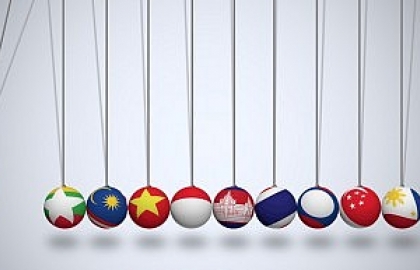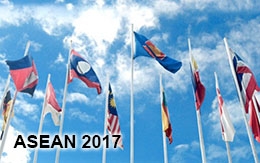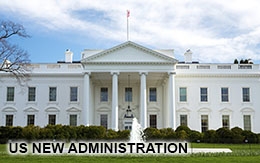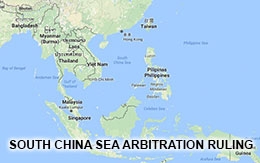The ‘South Sea’ and ASEAN: Failing Unity amidst Beijing’s Duplicitous Diplomacy
The Association of Southeast Asian Nations (ASEAN) has sought to address the challenges of the disputes in the South China Sea for close to a quarter of a century. This paper examines the circumstances and extent to which ASEAN has been effective in its response to the South China Sea dispute as well as the manner and means by which Beijing’s approach to the dispute has been influenced at the regional level.

The Association of Southeast Asian Nations (ASEAN) has sought to address the challenges of the disputes in the South China Sea for close to a quarter of a century. This paper examines the circumstances and extent to which ASEAN has been effective in its response to the South China Sea dispute as well as the manner and means by which Beijing’s approach to the dispute has been influenced at the regional level. For this purpose, it proceeds in three parts. The first section examines how ASEAN was initially able garner a strong ‘consensus’ position over the South China Sea,a but later developments, such as membership expansion and the East Asian Financial Crisis, undermined such unity. The second section examines China’s political and economic rise from 1995 and its associated impact on the utility of ASEAN in the traditional security sphere. The final section reviews the recent period when the maritime region became the more significant focal point of international attention (e.g., through the construction of seven artificial islands) and how this has decimated the goal of ASEAN centrality. Moreover, individual members have since abandoned their faith in the good offices of the Association and instead sought self-help measures such as international arbitration. This, in turn, has resulted in a relatively greater impact on Beijing’s cost-benefit analysis regarding the South China Sea. Finally, this paper refers to the maritime region as the ‘South Sea’ rather than the ‘South China Sea’. This is because the term ‘South Sea’ is far less biased than reference to a specific nation.
ASEAN: From Unity to its Gradual Loss of Leadership in the South Sea
Early ASEAN–China relations were turbulent and caught up in the bipolar cleavages of the Cold War. Aside from the resentment of certain ASEAN members about Beijing’s support for some Southeast Asian communist insurgencies at the time, China perceived the original ASEAN five members (Indonesia, Singapore, Malaysia, Thailand, and the Philippines) to comprise a pro-western capitalist block. Given this state of affairs, and that it was only in 1990 when Singapore and Indonesia established diplomatic relations with China, the accomplishment of a unified response by ASEAN was relatively easy when Beijing sought to reinforce its claim to 80 per cent of the South Sea through the 1992 ‘Law of the Territorial Sea and Contiguous Zone of the People’s Republic of China’. The area claimed by this purported ‘Law’ conflicted with the claims of four of the then six ASEAN members (Brunei joined ASEAN in 1984). At the time, China had also authorised the US Crestone Energy Corporation to undertake a seismic survey of hydrocarbon reserves within Vietnam’s continental shelf.
On 22 July 1992, ASEAN responded through the ASEAN Foreign Minister’s ‘Declaration on the South China Sea’ and urged ‘all parties concerned to exercise restraint with a view to creating a positive climate for the eventual resolution of all disputes’. The foreign ministers further recognised that a failure to prevent ‘adverse developments in the South China Sea [would] directly affect peace and stability in the region’ and therefore called for the establishment of a ‘code of international conduct over the South China Sea’. During the same year, ASEAN indirectly reinforced its position on the South Sea through the treaty on the ‘Southeast Asia Nuclear Weapon-Free Zone’. Beijing was quick to oppose it because, among other things, the treaty explicitly referred to and articulated the region’s continental shelves and Executive Economic Zones. Because of this, Beijing was worried that its accession to the Treaty would, in a de facto sense, prejudice its own maritime claims and therefore declined ASEAN’s subsequent offer for it to accede to the Treaty.
In 1995, ASEAN was also able to garner a collective position in response to Beijing’s construction of facilities on Mischief Reef. This reef is claimed by the Philippines and is well within its EEZ – situated just 145.5 nautical miles from the Philippines’ coast (Palawan Island). The ASEAN Foreign Ministers again responded by expressing their ‘serious concern over recent developments which affect peace and stability in the South China Sea’; a plea for all concerned parties ‘to refrain from taking actions that de-stabilise the situation’; and added that ‘[w]e specifically call for the early resolution of the problems caused by recent developments in Mischief Reef’. The statement also provided an early attempt to secure and maintain ASEAN centrality over such issues by encouraging ‘all claimants and other countries in Southeast Asia to address the issue in various fora, including the Indonesia-sponsored Workshop Series on Managing Potential Conflicts in the South China Sea’. These declarations, together with several other statements during the period, reinforced a perception that ASEAN could muster a collective diplomatic voice when necessary. ASEAN’s united response also impressed Hanoi and contributed to Vietnam becoming a member of ASEAN in 1995.
ASEAN’s early position on the South Sea has been attributed as one of the reasons why Beijing’s strategy shifted to a more exclusive focus on the deployment of soft power or Joshua Kurlantzick’s depiction of a ‘charm offensive’. However, it is important to acknowledge that Beijing’s calculus was also affected by Manila’s attempt to more strongly involve the United States in the dispute by restarting joint exercises and creating new defence agreements. Therefore, Beijing’s ‘charm offensive’, together with its increasingly significant economic inducements linked to Beijing’s political and strategic interests, was designed to be much more subtle, incremental, and to maintain a benign appearance that avoided any noteworthy state ‘costs’. This approach proved effective and the Association’s leadership over the South Sea issue subsequently began to wane.
Between 1997 and 1999, Beijing’s ability to create and then exploit divisions between the ASEAN members was greatly aided by the expansion of ASEAN to include Cambodia, Laos, and Myanmar as members. Moreover, the expansion of ASEAN’s membership to embrace all of Southeast Asia was simultaneously undermined by the devastating effects of the East Asian Financial Crisis (1997–1998), which crippled several economies; led to leadership change in Indonesia and Thailand; and left the impression that the ‘only shared regional value’ was recourse to a Darwinian notion of survival of the fittest. For the new ASEAN members, the early years in the Association were a bitter disappointment and their regimes had to depend as much as ever on foreign aid, investment, and other forms of assistance.
Amidst this setting, the ASEAN states took five years to complete a draft Code of Conduct (CoC) and, by this time, Beijing had also drafted its own CoC. In March 2000, both sides agreed to exchange their drafts and consolidate them into a single text. However, as the late Barry Wain states, ‘disunity developed on the ASEAN side, with Malaysia supporting China’s preference for a non-binding statement which led to the Declaration of Conduct of Parties in the South China Sea’ (DoC). The DoC contains five confidence-building measures and a range of principles (guidelines) that were designed to prevent any escalation of tensions. However, there has been little tangible progress in their realisation and the DoC guidelines are primarily noteworthy for the extent to which they have been breached.
Meanwhile, the fracturing of the ASEAN position continued to widen and the Philippines stunned its ASEAN counterparts when it unilaterally entered into the ‘Agreement on Joint Marine Seismic Undertaking in Certain Areas of the South China Sea’ (JSMU). While Hanoi was initially very opposed to this, it did eventually join the JSMU. At the time, interlocutors in Hanoi argued that there was little hope of a unified ASEAN position and so ‘self-help’ was the only option – a perception and reality that has continued to undermine the good offices of ASEAN through to this day. In any event, by 2007, the JSMU collapsed. However, most importantly, it appears that Beijing’s experiment in limited collaboration with ASEAN – whilst conducting under-the-table negotiations with individual ASEAN states – did not lead to any tangible advance of its ‘material interests’. Therefore, Beijing’s strategy in the South Sea once again shifted.
...
Christopher B. Roberts is Associate Professor and Director of the National Asian Security Studies Program (NASSP) at the Australian Defence Force Academy campus of the University of New South Wales in Canberra.
The paper was presented at the Conference: "The South China Sea in the Broader Maritime Security of the Indo-Pacific Conference", 28-30 September 2016, Canberra, Australia. This conference is co-organized by UNSW Canberra at the Australian Defence Force Academy (ADFA), the Diplomatic Academy of Vietnam (DAV), and the Japan Institute of International Affairs (JIIA).
Click here for full text.










